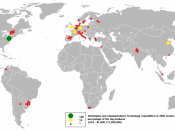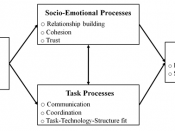Introduction
Virtual team was an invention found out few years ago and is defined as "a team made up of geographically or organizationally dispersed members who share a common purpose and are linked primarily through advanced information technologies" (Daft 2005, p. 405). The invention started from the improvement of technologies around the world, which "allows organization to manage greater number of projects without the cost and wasted time to face to face meetings" (Foster & Ball 2000, p. 1). The technologies most commonly used include e-mail, voice mail, videoconferencing, internet and intranet technologies, and various forms of software (Daft 2005, p. 406).
Virtual team can sometimes be called as global team. Example of it is "American express Technology (AET); it uses the human resources team whose members are around the globe which helps technology experts partners with business leaders around the world to coordinate their work" (Daft 2005, p.408). It has both strength and weakness, which significantly determine success or failure.
This report will discuss about these strengths and weaknesses and how to manage domestic and international virtual teams.
International Virtual Teams
International virtual teams consist of members who are separately located in different countries, e.g. Australia, China and Indonesia.
Research confirms that the greatest challenge for virtual team is the cultural challenge, in terms of company's culture and differences in the geographic culture, such as cultures, languages, business practices and attitudes towards the hierarchy and power.
This issue becomes obvious when leading and managing international virtual teams. Since globalization grows rapidly, the cultural differences present significant risk. It is critical that leaders adhere to guidelines in the formation, support and management of these teams (Gender Research, 2002).
Six guidelines have been identified by Gender Research (2002) and these would significantly increase the effectiveness and cohesion of these teams:
1. Beware of cultural risks
2. Be mindful of local HR policies
3. Budget for an initial face-to-face meeting
4. Rotate team meeting times
5. Coordinate technology tools with local Information System management
Domestic Virtual Teams
Domestic virtual teams are groups based nationally. For example, one member can be in Melbourne; the others are in Sydney and Brisbane (i.e. all are in Australia).
Compared to international virtual teams, domestic ones are different as they possess the same culture backgrounds, languages, education, business polices, practices and attitudes towards the hierarchy and power. This can lead to better communication and understanding, more convenience and efficiency. The way of managing domestic virtual teams is easier, due to a smaller business environment.
Leadership in Virtual Teams
In a virtual team, everyone may be involved in a relatively small team that sees something that should be done - then does it. All members are leaders in their own domains (Lipnack & Stamps 2000, p. 3). Thus, 'virtual teams are leader-full, not leader-less' (Lipnack & Stamps 2000, p. 176). Virtual leadership is about maintaining everyone focused as old structures, including old hierarchies, deteriorate. Raymond Smith, CEO of Atlantic Bell explained his idea that leadership on virtual team will likely be decided by who's most expert on the matter at hand - not by corporate hierarchy (Gould, 1997).
Virtual teams usually comprise at least two kinds of leaders - social leaders and task leaders. Task leaders are oriented to expertise, activities and decisions required to accomplish result, while social leaders arise from interactions that generate feelings of group identity, status, attractiveness and personal satisfaction (Lipnack & Stamps 2000, p. 178).
Benefits
The concept of virtual team is already commonly used in many big companies, such as Shell Oil Company, Ernst and Young, and General Electric. Regardless of the trouble of working across boundaries, when successful, virtual teams considerably improve business performance. By the existence of virtual teams, we are now able to do together what we cannot do alone (Lipnack & Stamps 2000, p. 21). Some other benefits include (Lipnack & Stamps 2000, p. 22):
* Decrease of costs by cutting travel costs and time. This will then construct "e-economies" of scale, and design better digitally enhanced processes.
* Shorter cycle time by shifting from serial to parallel processes. This will set up better communications, and create more wide-spread trust.
* Improved innovation by allowing more diverse participation. This will inspire product and process creativity, and encourage new business development synergies.
* Leverage in learning by capturing knowledge in the natural course of doing the work, obtaining wider access to expertise, and distributing best practices.
Weaknesses
Virtual team mainly depends on Information Technology to achieve long-distance communication and coordination. However, some weaknesses can be encountered:
1. Obstacle in communication
* Lack of mutual contacts between members, such as imperceptibility of language information, physical information, and the acts of information expressed by ideas, views and attitudes, can decrease team work efficiency.
* Contacts between members are generally formal communication, not informal communication which often helps members accumulate technological innovation and form a cohesive team. This may reduce the sense of isolation and anxiety among members and it will also impact on the team goals.
2. Coordination problems
* Each virtual team member is self-independent. Putting these strong individuals together will create a great challenge because each member is in a different area with different daily routine and different working method. This will increase difficulty in cooperating with each other. Also each member's IT proficiency may vary and this can inevitably slow transmission process and individual feedbacks, thus decreasing the efficiency of the entire team.
3. Members' ethical risks
* A virtual team is based on a long distance management. Due to being rational and self-independent, there is a greater chance for member to leave the team easily. Should that happen, it will impact on the progress of the project since information and skills are depleting.
4. Breakdown of communication facilities
* A breakdown of communication equipments, such as power outages, machinery damage, broken wires and network congestion, will completely disrupt and affect the normal operations of the virtual team.
Case Study: Problems within Virtual Teams
Gail Corbitt, et. al. (2004) carried out a study about an empirical analysis that compares virtual with face-to-face teams in terms of team trust, performance issues and team developmental stages. The result indicated both virtual and face-to-face teams bring relatively high initial trust to the team experience. They believe that trust is important to team performance for both teams. For team developmental stage, both teams spend similar proportions of time in each team formation stage. Finally, there is no significant difference in results produced by both teams. For more complex tasks, virtual team needs richer communication medium to be successful.
Another case study was "Real problem with virtual team". The problems received are:
* Lack of co-ordination: teams did not appear to have a clear assignment of roles and responsibilities.
* Minimal interaction: low level of interaction amongst team members as evidenced on team discussion board.
* 'Get it over with' mentality: teams try to finish the assignment quickly rather than focus on the educational insights that the assignment has to offer.
* Lack of deep discussion: fear of upsetting team harmony or the thought that having deep discussion would delay the completion of the team assignment.
* Clinical versus heated discussion: virtual team nature is that asynchronous tools. A team member has time to think over a message posted by another team member and formulate response (Vonderwell, 2003).
* Free riders and easy riders.
How to overcome the problems
* More establishments on team early on
* Identify overall goals, and tasks that need to be completed
* Divide responsibilities and assign editor or project managers to remind and edit document
* Focus on task oriented and increase more interactions with team member
* Focus for on-task information rather than try to run over it
* Create deep and clear discussion to get better result in assigned work
* Build up team management skills and be responsible for your own tasks
* Develop trust on team member
Conclusion
The concept of virtual team offers a lot of benefits if practiced in today's world. Especially with the improvement of Information Technology and everyone going in a wireless world, it is not possible to have this virtual team replacing the regular team soon. Job position is not like in the old days, where people worked securely with a full-time position. Now, companies offer more projects and they only hire the right people to get these projects done for a period of time. This is where the virtual team comes in. It will provide the means of having "a group of people working interdependently with a shared purpose across space, time, and organization boundaries using technology" (Lipnack & Stamps 2000, p. 18).
Obviously, having a virtual team where face-to-face communication is limited can cause some problems. But, trust is the key to virtual teams. By having a high level of trust, "common goals, coordinated effort, unconstrained thinking, each person contributing, more competitive and all-channel open communication, the creative juices are really flowing" (Lipnack & Stamps 2000, p. 283).
References
Daft, R 2005, The Leadership Experience, 3rd edn, South- Western Thomson Creation, Canada
Gail, C, Lorraine, R.G and Lauren K.W 2004, A Comparison of Team Developmental Stages, Trust and Performance for Virtual versus Face-to-Face Teams, California State University, Chico
Gender Research 2002, Leading an International Virtual Team: Tips for Success, Tactical Guidelines, 11th January, TG-15-0425.
Gould, D 1997, Leading Virtual Teams, viewed 28/08/2006, http://www.leader-values.com/content/detail.asp?ContentDetailID=183
Lipnack, J and Stamps, J 2000, Virtual Teams: People Working Across Boundaries with Technology, 2nd edn, John Wiley and Sons, Inc., New York
Peterson, M. F 2003, Managing International Virtual Teams, Florida Atlantic University, September 15.
Wing L, Alton ,C and Jeremy B.W June 2005, Real Problems with Virtual Teams: An Analysis of the Factors leading to Dysfunctional Online Collaboration, U21Global


